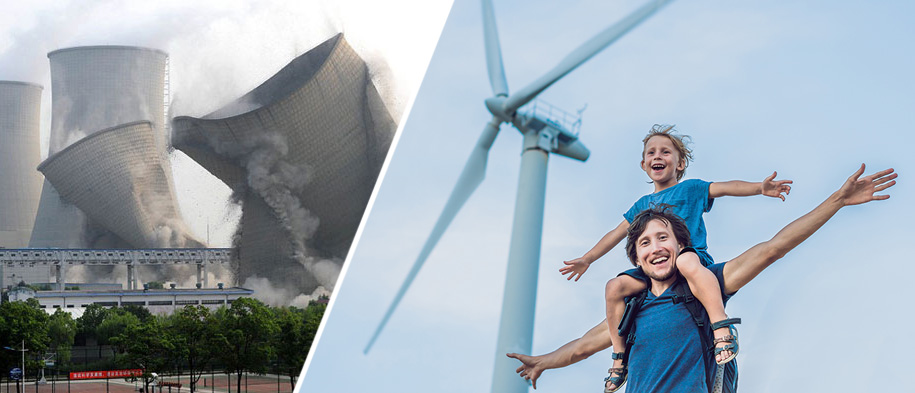Disruptive Energy.
While working as a journalist on World Coal magazine in the 1990s I was interviewing the president of a very large Canadian coal company who told me that in 10 years they would not be mining coal. Shocked by such a statement from a company head, I checked it was OK to print the quote. He said yes, we printed.
By any measure, that was a disruptive statement. We all use energy, yet most of us are blissfully unaware where our energy comes from, how it comes down the cable, through the petrol pump. Coal, oil, gas, wind, solar, nuclear. While more and more of us are becoming aware of the impact climate change will have on current and future lives and the planet we keep pressing the same buttons, switches and pedals that make the energy flow.
Our behaviours are riddled with hypocritical contradictions. Yet if climate change is going to be managed, we’ve got to make it easier for consumers to make good choices. We’ve got to look at supply, at demand and the connections between them.
First, let’s drift through a very potted history of the movement of environmental awareness to the masses.
Before global warming in the latter part of the 20th century, a relatively small group of people cared for the environment. Environmental concerns grew in importance and the United Nations commissioned Gro Harlem Brundtland, who served three terms as Norwegian PM, to chair a group to look at sustainable development. Our Common Future (1987) set the benchmark for environmental awareness and the requirements for sustainable living. Earth Summit 1992 followed in Rio, creating the Climate Change Convention. The Kyoto Protocol followed in 1997, with the Paris Agreement in 2015 setting meaningful targets that might just be enough to achieve the required changes.

Countries and consumers across the world are embracing renewable energy
Lots of paper, lots of chat, and, dare we call it, lots of hot air. But what has really happened? Anything, nothing. Well, that depends on who you ask. I’d venture quite a lot. Costa Rica has generated over 98% of its energy from renewables since 2014. In March 2018, Portugal created all of its energy requirements from renewables and had some spare.
Both countries are beautiful, in their own respective ways. Neither is a massive consumer of energy. According to the World Bank, Costa Rica used 1370 watts per capita in 2013. Portugal used about double that, with China at 964 watts. The UK is just short of 4,000 watts per person, while the US is over double that at 9207 watts per person. So what are the big gas guzzling countries up to? There are changes with marginal gains to be found. In June 2018, the UK generated more power from renewables plus nuclear than from gas and coal together for the first time. In 2017 the guaranteed price of power from a new offshore wind power generation became cheaper than new nuclear power for the first time. These may seem like small changes, but they reveal a big shift in mindset.
And it’s happening all over the world – take a look at 12 Countries Leading the Way in Renewable Energy from ClickEnergy and you might be surprised to see some of the names (yes, the USA and China) on the list.
Demand side options are improving. It seems life could be easier for users who would like simple ways of using less energy. Could be easier? It should be easier. What about a simple device to attach to your washing machine so it turns on when the wind farms are generating power outside peak demand? Or a charging socket that switches off when your phone battery is fully charged (most continue to provide a trickle charge). There are many unmet needs that want a simple, affordable, human-scale solution.
BBC Radio Five are spending the entire week looking at what people can do at a personal level to tackle climate change with their Cool Planet series.
So what about the connections and connectors between supply and demand. Not the generators or users of power, but the suppliers. With the increased supply of renewable energy, renewable energy suppliers are emerging.
Bulb is a new energy supplier in the UK that’s disrupting the energy supplier market. With 950,000 members, they’re just 1/5th the size of E-ON UK, the smallest of the UK’s Big Six. The near million members are getting cheaper fuel, lower bills and preventing 1.4 million tonnes of CO2 emissions a year – that’s like planting 722 million trees. Bulb are growing, fast. The UK is getting greener every year. In 2018, 33% of the country’s power came from renewables (39% gas, 20% nuclear, 5% coal, 3% other).
The energy sector – generators, suppliers and consumers – wants change as a sector and as people. More than 2 million homes got their energy from a 100% green electricity supplier like Bulb.
So if you’re a small innovator busting to make meaningful contact with the big power companies, drop us a line. We’ve got our Innovation Radar service that helps organisations identify prospective partners, suppliers and the like. And if you’re a big company working hard to innovate and struggling for impact, get in touch.
Don’t waste energy trying to do it on your own